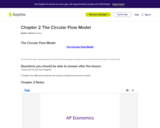
This lesson summarizes how chemical reactions occur, and that not all reactions go to completion. [1:41]
- Subject:
- Science
- Material Type:
- Lesson
- Provider:
- Sophia Learning
- Date Added:
- 08/07/2023

This lesson summarizes how chemical reactions occur, and that not all reactions go to completion. [1:41]

An illustrated tutorial describing the structure and function of the chloroplast organelle in a plant cell. [0:37]

A tutorial explaining how to use technology to create graphics and visuals to enhance documents and presentations. A brief audiovisual presentation identifies types of visuals, and another audiovisual presentation describes how and when to use nine types of graphics. Also includes a slideshow describing the technology needed to create graphics and a list of questions to help determine when to use graphics and visuals in documents or presentations. [19], [7:17] SL.9-10.5 Audio Visuals, SL.11-12.5 Audio Visuals

This screencast focuses on chronological, or time-ordered, transition words. It explains the need and uses for these transitions, provides a short list of transition words, and examples of how to use them in different types of writing. [2:26]

Enhance the learning process by using this video tutorial to better understand circular flow models and the relationship between households, markets, and firms in a competitive market. [12:37]

A video lesson explaining the importance of clarity in effective writing and showing some examples of how to make writing more clear. [9:45] W.11-12.4 Clear/Coherent Writing CCSS.ELA-Literacy.WHST.6-8.2.c and CCSS.ELA-Literacy.WHST.6-8.4

This lesson will introduce the systematic classification of matter used in chemistry, defining the terms heterogeneous, homogeneous, pure substance, mixture, compound, element and providing examples.

This video tutorial describes how to classify quadrilaterals using key characteristics such as parallel sides and right angles. [4:27]

Quadrilaterals are explored in this video lesson. The tutorial describes the characteristics of various quadrilaterals. Students can check their understanding with an assessment. [6:17]

This video lesson describes and provides examples of right, acute, and obtuse triangles. Students can check their understanding with an assessment. [2:24]

This video lesson shows examples of classifying triangles by their angle measurements. Students can check their understanding with an assessment. [3:54]

This video [2:18] introduces clauses and discusses how to recognize them. It is 1 of 5 in the series titled "Clauses." Incldues a short quiz.

This video lesson focuses on the rules for using colons. Includes a multiple choice quiz to check for understanding. [2:28] L.9-10.2b Colons

A screencast lesson introducing colons and explaining their uses within sentences and in conventional situations. A brief quiz is provided to assess the use of colons in sentences. [2:14] L.9-10.2b Colons

A set of two cartoon videos. The first [5:08] explains colons and how they can be used properly in sentences. The second [3:42] introducing dashes, their usage, and how they can be used to create tone.

Watch a video and click through a nine-slide presentation to learn where commas came from, how they are used properly, and when they should not be used. [7:27]

A screencast lesson explaining common errors when writing an introduction and how to avoid them. [8:19]

An introduction to the common characteristics shared by all living things. [1:26]

This video lesson focuses on common issues with conclusions such as simply restating the thesis and summarizing the research. Starting with a simple conclusion, she shows its issues and discusses how to make it show the impact of what was learned and connect with the reader. [11:12] CCSS.ELA-Literacy.WHST.6-8.1.e

This lesson goes over similar words that are commonly confused. [9:36]